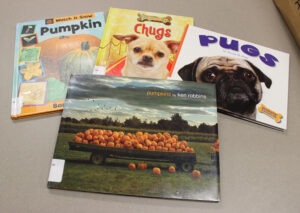Did you ever notice that books about pet dogs are shelved closer to books about vegetables than books about wolves? It’s all because of the Dewey Decimal System, through which our library organizes all nonfiction books and a few types of fiction books. Melvil Dewey developed the system at Amherst College in the 1870s, and his methods have been adopted by thousands of libraries across the world, with various modifications over the years. The full official guide to the Dewey Decimal System is a set of four thick books, and costs several hundred dollars. But I’ll try to explain some of the basics here, for free!
Within the Dewey Decimal System, numbers between 000 and 999 are used to represent different topics. These numbers are divided into ten broad “classes” of knowledge:
000-099: Computer science and general works
100-199: Philosophy and psychology
200-299: Religion
300-399: Social sciences (economics, law, education, etc.)
400-499: Language
500-599: Natural science (physics, chemistry, biology, etc.)
600-699: Technology, or “useful arts” (medicine, engineering, agriculture, etc.)
700-799: Fine arts and recreation
800-899: Literature[i]
900-999: History and geography
Each class is further and further divided into narrower topics. For example, within the 500s, the 590s are dedicated to zoology, and number 599 is used for mammals. But we don’t have to stop at whole numbers! This is where the “decimal” part kicks in, allowing for more precisely defined topics. Going deeper into one part of the mammal section, 599.7 refers to carnivorous mammals, 599.77 refers to the dog family, and 599.773 refers to wolves. Even three decimal places may not be good enough for some people; we could keep dividing all information about wolves into more granular subtopics, and reach a number like 599.77309787. (That’s for wolves in Wyoming.[ii]) But hopefully, you get the idea.
Once our cataloger has found the Dewey Decimal number that best represents the subject of a book, that number is combined with a three letter code (usually derived from the author’s last name) to form the full call number. For example, the call number for Wolf by Garry Marvin is 599.773 MAR. That call number appears on the spine label of the book and in the online catalog entry. If you know the call number, you should be able to find the book on the shelf – but don’t be afraid to ask for help! Note that some books in our collection have shorter call numbers than others. Walker’s Mammals of the World (by, uh, Ronald M. Nowak) is at 599 NOW, because it covers all mammals; there’s no need to get into decimal places.
 Sometimes, specific aspects of a broader topic may be spread out across far-flung numbers. Biologically speaking, pet dogs and wolves are part of the same family, but to find books on pet dogs, you need to go all the way to 636.7. Wild animals are considered the domain of zoology, but domestic animals are classified under 636, the number for animal husbandry. Going up another level, the 630s as a whole are used for agriculture; so, essentially, the Dewey Decimal System treats pet dogs as a subset of agriculture! Thus, books about pugs are just a short hop from books about pumpkins.
Sometimes, specific aspects of a broader topic may be spread out across far-flung numbers. Biologically speaking, pet dogs and wolves are part of the same family, but to find books on pet dogs, you need to go all the way to 636.7. Wild animals are considered the domain of zoology, but domestic animals are classified under 636, the number for animal husbandry. Going up another level, the 630s as a whole are used for agriculture; so, essentially, the Dewey Decimal System treats pet dogs as a subset of agriculture! Thus, books about pugs are just a short hop from books about pumpkins.
Luckily, you don’t have to memorize this stuff; our online catalog will point you in the right direction. But if you want to learn more about the Dewey Decimal System, you can find a list of all the whole-number sections here. By the way, I think my all-time favorite Dewey Decimal number is 999, reserved for extraterrestrial worlds. At the moment, we don’t have any books in our library under this number, but who knows what the future will bring. Keep watching the skies!
[i] In theory, all literature could go in the 800s, but we mainly use the 800s for things like poetry, drama, essays, and foreign language fiction. Most of our novels and picture books are organized by the authors’ last names. (Trust me: it’s much easier for everyone that way!)
[ii] Even the full official Dewey Decimal guide does not list every possible Dewey Decimal number, but there are various rules you can use to create custom numbers for really specific topics. With some mental gymnastics, it’s possible to produce a Dewey Decimal number with twenty-odd digits!

